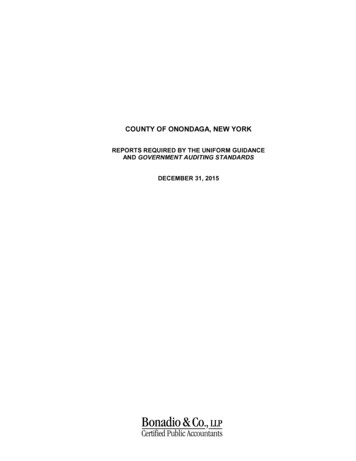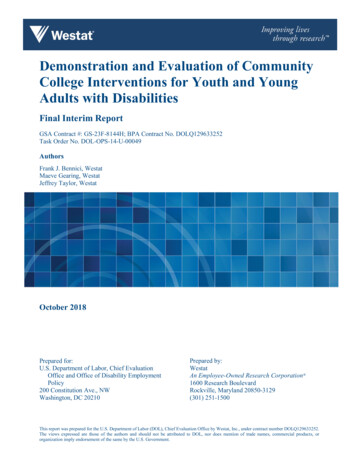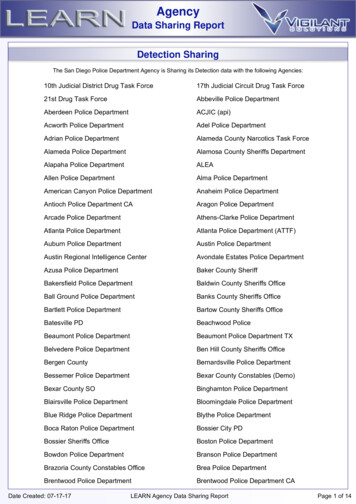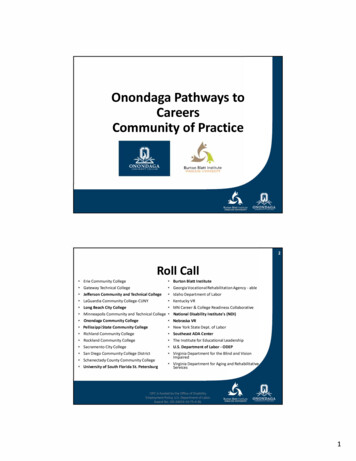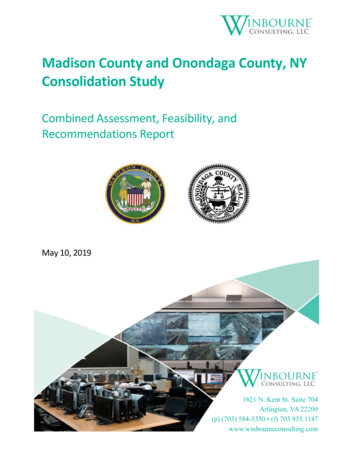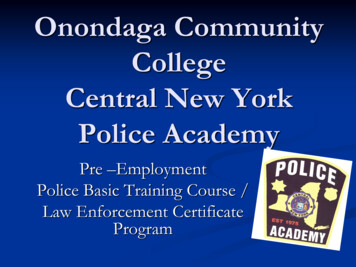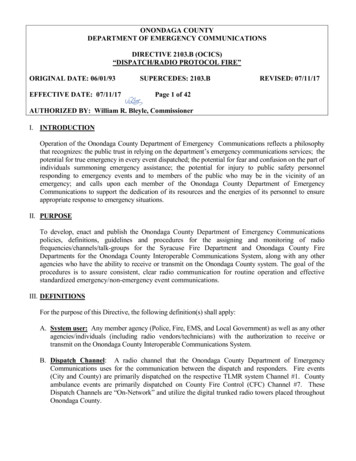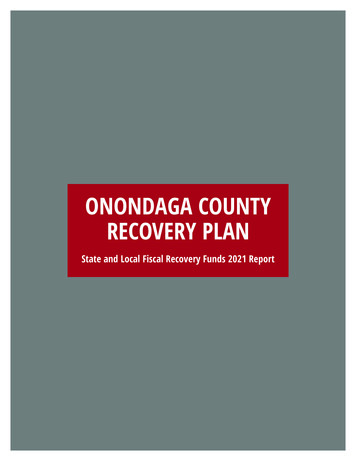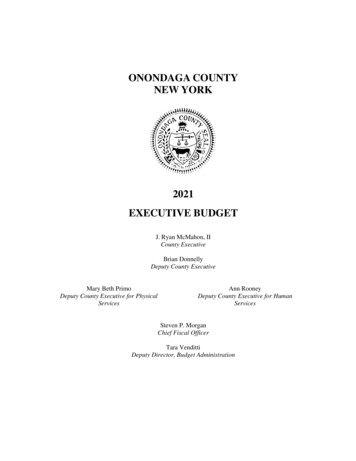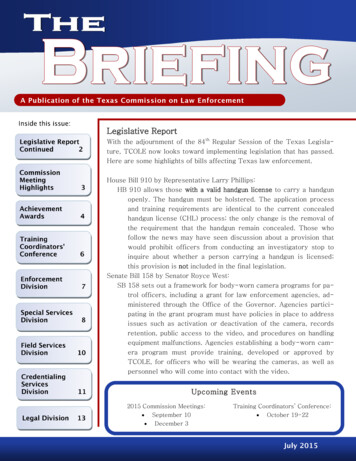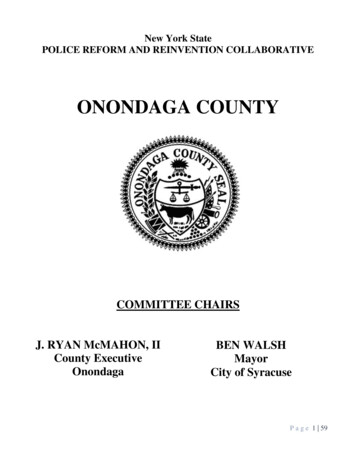
Transcription
New York StatePOLICE REFORM AND REINVENTION COLLABORATIVEONONDAGA COUNTYCOMMITTEE CHAIRSJ. RYAN McMAHON, IICounty ExecutiveOnondagaBEN WALSHMayorCity of SyracuseP a g e 1 59
Content OutlineExecutive Summary . . . .3Introduction to the Collaborative Process . . . .4 Public Comments by InterFaith Works Community Forums Governor’s Executive Order 203 Accountability GoalsPOLICE STRUCTURE SUB-COMMITTEE . . . 9Chief Kenton Buckner / Chief Joe Cecile, co-chair Use of Force Policy Body Worn Camera Policy No Knock Warrant ProceduresPOLICE/COMMUNITY RELATIONS SUB-COMMITTEE . . 10Council President Helen Hudson, co-chair Citizen Review Board Procedural Justiceo Right to Know Law Violence Interrupters: Reduction Intervention School Safety and Security Diversity HiringCRIME ANALYSIS SUB-COMMITTEE . . . 23Sheriff Gene Conway / Chief Joe Ciciarelli, co-chair Problem Oriented Policing Hot Spots Focused Deterrence Environmental Design Role of Crime Analysis Center (CAC)TRAINING SUB-COMMITTEE . . . 29Chief Mike Crowell, co-chair Racial Bias: (Racial Justice in Policing) De-escalation: Focused deterrenceo Implicit Bias Awareness Training Crisis Intervention: Law Enforcement Assisted Diversion ProgramALTERNATIVES TO POLICE RESPONSE SUB-COMMITTEE . 42County Legislature Linda Ervin, co-chair Proper Response to Non-Criminal Calls Diversionary Programs and Courts Community Court: (Restorative justice)APPENDIX . .51P a g e 2 59
Executive SummaryThe collaborative process has been a comprehensive approach to seek out communityengagement with the goal to improve relations between our communities and police.Recognizing we cannot have a strong community without strong neighborhoods and strong lawenforcement partners. This document is the beginning of a process and our goal at the end is tohave a stronger community because of the work that has been done. – J. Ryan McMahon, IIThe Onondaga County Collaborative is a successful endeavor by community stakeholders andlaw enforcement across our Towns, Villages, City and County. We recognize that the publicperception of the police and policing is not the same across this County, but thanks to GovernorCuomo's executive order this Collaborative has developed a process that brought togetherstakeholders throughout our county to facilitate plans across municipalities to improve bothcollective perception and what law enforcement looks like across the board. Let this initiativebe the beginning of more unified efforts to address the common issues each resident andcommunity deals with in their own way, as one. – Ben WalshAcknowledgementsThis collaborative is driven by the dedication and commitment of community volunteers, civilleaders and key stakeholder who took time out of their lives to work toward building a safer,more fair, and equitable Onondaga County. These individuals along with other members of theOnondaga County Police Reform and Reinvention Collaborative have worked diligently toimprove their community and their home.- Thank youCollaborative DisclaimerPlease note: To the extent this collaborative report lacks specificity and or appears overlygeneral in relation to the fourteen subject areas addressed within the Governors executive order203 please refer to your local agency’s tailored municipal police reform plan approved by yourlocal legislative body. This report only represents the overarching plan and goals for all lawenforcements bodies under the jurisdiction of Onondaga County.P a g e 3 59
Introduction to the Collaborative ProcessSimilar to other communities in New York State, Onondaga County has combined with allmunicipalities within the county, to address a comprehensive plan for reform.While this collaborative effort creates a baseline for all government entities within OnondagaCounty with a police agency operating with law enforcement officials, the Executive Orderrequires that each department develop its own plan for police reform. Prior to and leading up to2020, voices of from citizens in the City, County and State have spoken-up, joining the nationalchorus, regarding the need for comprehensive police reform.The summer of 2020 accelerated police reform efforts: National: State: Local: George Floyd Justice in Policing Act (HR 7120)NYS Lawmakers pass 10 bills & Governor’s EO 203Syracuse Mayor Walsh issues Executive Order (See Appendix A)Public Comments (presented by InterFaith Works) See Full Report Appendix BThe Police Reform and Reinvention Collaborative (“PRRC”) conducted six community forumsin January 2021 to gather public comment about initiatives to be undertaken in OnondagaCounty and the City of Syracuse to address police reform pursuant to Executive Order No. 203,signed by Governor Andrew M. Cuomo on June 12, 2020. The PRRC engaged InterFaithWorks, a Syracuse-based human services non-profit agency, to gather all data based on publiccomments for each session and to develop this independent report.The report qualitatively analyzes 211 public comments made by 375 participants aboutreforming and redefining the role of police in Onondaga County and the City of Syracuse.Seven overarching themes emerged, identified below. For ease of reference, the themes belowserve as a table of contents for this report.o 7 Themes From Public Comments Community TrustPolice Demeanor, Brutality, and ProfilingMental Health/Alternatives to PolicePolice Organization and StructureSystemic Racism and PovertySchools and YouthRecruitment and TrainingP a g e 4 59
Community ForumsThe dates of the forums were January 7, 12, 13, 14, 19, and 20. Each were held via a Zoomplatform from 5:00 – 6:30 pm. The forums were initially designed for participants from specificgeographic regions of Onondaga County and for the City of Syracuse.Participants were asked to supply their zip code for later identification between the commentand the municipal police department. This report does not control for City and non-Cityrecommendations due three reasons - inconsistent provision of zip codes, the appearance ofgeographic mixing for the sessions, and making “global” recommendations about police ratherthan specific to the commenter’s location. More importantly, the themes that emerged fromthese sessions appear to be broadly applicable across municipalities within Onondaga County.There are specific references to certain municipalities which are identified in more detail below,but these are derived from the public comments rather than attributable by zip code.Total attendance across the six Community Forums was 375 participants on a session-bysession basis. Multiple people attended multiple sessions and not everyone attended the entiretyof their session. Attendance was determined by Zoom participant lists provided in Excel format,with duplicate names per session deleted. Duplicate entries appear likely due to connectivityinterruptions requiring participants to reenter the meeting and thus be logged as a newparticipant by Zoom.Table 1: Attendance by sessionDateAttendanceJanuary 7, 202155January 12, 202170January 13, 202181January 14, 202168January 19, 202154January 20, 202147Total Attendance375The Community Forums were facilitated by Nodesia Hernandez and Pastor Dr. H. BernardAlex, each of whom served as the lead facilitator for three sessions each. The sessions wereopened by members of the PRRC by setting the framework for each discussion. The sessionswere designed and initially conducted to be listening sessions for Collaborative and lawP a g e 5 59
enforcement members, but government leaders did address specific inquiries raised by publicparticipants. It was common, for example, for City and County government leaders to indicateif a citizen complaint was received and was being acted upon.There were a total of 211 separate suggestions made by the public during the six CommunityForums, for an average of approximately 35 suggestions per Community Forum. Participantsoften made more than one suggestion. Understanding the Public Comments ReportPublic participants offered an array of recommendations and suggestions, many of which weredrawn from personal and professional experiences with police. There was a perceived need forand recognition of the importance of the police while expressing a simultaneous concern aboutpoor demeanor and profiling, and lack of trust. We observe promise in the form of participantrecommendations about building police-community trust and addressing organizationalchallenges that police departments face, such as responding to people in mental health crisis.We observe opportunities for the Collaborative and the legislatures across Onondaga County toaddress head-on the many shared stories of poor officer demeanor, profiling, and brutality byparticipants who identified as black or brown or persons of color.The themes represent both frequency of their mention but also uniqueness of the theme. For theformer category, the theme of “police demeanor, brutality, and profiling” was an obvious themenot just for the frequency but for the stories that were used to illustrate the theme. For the latter,the theme of “schools and youth” received relatively few mentions but is also highly specific.Additionally, it may be important to consider the age of the Community Forum attendees: thereappeared to be few youth participants, so “schools and youth” might be a category that isunderrepresented in terms of potential reform opportunities.A different example is “systemic racism and poverty”. Some could suggest that it was perhapsthe major theme of all six sessions (many issues, like racial profiling and police demeanor andbrutality, affect our black and brown neighbors the most). This appears to be valid based on thefollowing report found in Appendix B.However, issues of demeanor, brutality, and profiling may be able to be addressed in specificways by the Collaborative and by the legislative bodies that receive this report. For purposes ofthis report, “systemic racism and poverty,” while referenced less frequently, still represents animportant area of consideration that is more complicated: interactions across systems, differentlevels of government, and perhaps with entities outside the immediate authority of the PRRCand the legislative bodies within Onondaga County. An example of this is the members of theOnondaga Nation, sovereignty, and historical racism.P a g e 6 59
We encourage the reader to consider the totality of all suggestions made as important elementsfor addressing police reform and reinvention. There are clear themes that emerge, but we expectthat meaningfully addressing police reform and reinvention requires equal consideration of allpossible solutions put forth regardless of their frequency. 7 Themes Definedo Rebuild community trust. This is a complicated theme involving: (1) therecognition of the importance of the police role in our communities, (2) the needfor greater accountability structures and transparency of these structures, and (3)efforts to meaningfully rebuild relationship between police and communitymembers.o Address police demeanor, brutality, and profiling. This is the most prominenttheme mentioned during the Community Forums, and was communicated throughmany shared experiences by black, brown, and people of color of demeaningtreatment, brutality, and profiling. No white participants were observed to sharesimilar experiences. Solutions to these challenges will be difficult but may beaddressed, at least partially, by the solutions offered in rebuilding communitytrust, above.o Improve recruitment and training. Addresses participant comments aboutfostering increasingly diverse police departments that meet or exceed minorityrepresentations in our municipalities and our County or about fostering, in thewords of one participant, “a diversity mindset” around new hires and trainings.o Engage mental health / alternatives to police. There was resonance across theCommunity Forums for the need for expanded mental health services to augment,or perhaps replace in certain instances, police interactions with people in mentalhealth crisis.o Enhance police organization and structure. This category reflects the “businessprocess” aspects of policing – numbers and allocations, response times, callresponse, programs like gun reduction, and the ability to access police records.Good policing models were referenced and positive interactions with police werenoted.o Address systemic racism and poverty. The theme of systemic racism andpolicing could be interpreted to be the major theme of across the CommunityForums. This category is best understood as being multi-disciplinary andintergovernmental, at the very least, with “solutions” being ones that are lessobvious that other ones addressed more specifically above.P a g e 7 59
o Engage schools and youth. Schools and youth may represent a unique opportunityacross the Community Forums: there was very little observed input from youthabout their experiences generally and in their schools. As such, the PRRC and thevarious legislative bodies in Onondaga County may wish to consider a specificengagement of youth perspectives. Gov. Executive Order 203 (14 Areas of Focus)Governor Cuomo’s Executive Order 203: (See Full Order at Appendix C)“Each local government entity which has a policy agency operating with police officers asdefined under 1.20 of the criminal procedure law must perform a comprehensive review ofcurrent police force deployments, strategies, policies, procedures, and practices, and practices,and develop a plan to improve such deployments, strategies, policies, procedures, andpractices, for the purposes of addressing the particular needs of the communities served bysuch police agency and promote community engagement to foster trust, fairness, andlegitimacy, and to address any racial bias and disproportionate policing of communities ofcolor.” Use of Force PoliciesProcedural JusticeRestorative JusticeProblem-Oriented PolicingHot Spots PolicingFocused DeterrenceImplicit Bias Training Model Policies & GuidelinesSystemic Racial Bias in PolicingViolence Prevention / Reduction InterventionsDe-escalation Training / PracticesCommunity-based OutreachLaw Enforcement Assisted Diversion ProgramsCrime Prevention by Environmental DesignAccountability GoalsAfter this plan is ratified or adopted by your legislative body: We will need to implement the plan & communicate progress reports/metrics to the public. We will need continuously to monitor and respond to community concerns with the police. Public engagement will not end on April 1st, 2021.Note: This Collaborative is an important step in the continual process of building, maintaining,and strengthening the relationship between our police department and our community.P a g e 8 59
POLICE STRUCTURE SUB-COMMITTEEChief Kenton Buckner & Chief Joe Cecile, co-chairsSupported by:Derek McGorkMark RusinAmanda Harrington Use of Force Policy: See Appendix D (City of Syracuse Model)o The Use of Force Policy provides a guideline on the reasonable use of force forofficers of the Department as part of their sworn duty to protect and serve thepublic. The policies set forth in this section are operational guideposts and theDepartment’s policy shall also include the standard, techniques and requirementscontained within the instruction provided to officers as part of their basic, inservice, and on-the-job training. While there is no way to specify the exact amountor type of reasonable force to be applied in any situation, every member of thisdepartment is expected to use these guidelines to make such decisions in aprofessional, impartial and reasonable manner.o The Department and this Policy recognize the value and sanctity of human life andthe dignity to be accorded to the citizens the Department is sworn to protect. Thispolicy equally protects the welfare and safety of the Department’s officers whoplace themselves in danger on a daily basis. Vesting officers with the authority touse reasonable force and to protect the public welfare and themselves requiresmonitoring, evaluation and a careful balancing of these interests.o Each individual agency will adopt a uniformed Use of Force Policy similar to thatof the City of Syracuse. Body Worn Camera Policy: See Appendix E (City of Syracuse Model)o The purpose of this policy is to provide Officers with instructions on when andhow to use body-worn cameras (BWCs) so that Officers may reliably record theircontacts with the public in accordance with applicable law.o It is intent upon this policy that Officers shall activate the BWCs when such use isappropriate to the proper performance of the individual Officer’s official duties andwhere the recordings are consistent with policy and law. This policy does notgovern the use of surreptitious recording devices used in undercover operations.P a g e 9 59
No Knock Warrant Procedures: See Appendix F (City of Syracuse Model)o This policy established guidelines for the planning and serving of arrest and searchwarrants by members of this department. It is understood that this policy cannotaddress every single or circumstance that can arise in the service of a search orarrest warrant, as these tasks can involve rapidly evolving and uniquecircumstances.o This policy is intended to be used in conjunction with a Operations Planning andDeconfliction Policy, which has additional guidance on planning and serving highrisks warrants. This policy is not intended to address the service of search warrantson locations or property already secured or routing field warrants arrests by patrolofficers.POLICE/COMMUNITY RELATIONS SUB-COMMITTEEHelen Hudson, co-chairSupported by:Ranette RelefordYusuf Abdul-QadirVirgil HutchinsonRasheada CaldwellTimothy Jennings-Bay (Noble)Ocesa KeatonScott HeggelkeMichael Buck Civilian Oversight and Other External Accountability(Model: Syracuse Citizen Review Board):The City of Syracuse Citizen Review Board (“Board”) is a hybrid oversight model1 createdthrough Local Law No.2011 (“Legislation”) with jurisdiction over the Syracuse PoliceDepartment (“Department”). The Legislation states the Board shall have the power toinvestigate complaints of police misconduct independent of, and concurrently with, anyinvestigations conducted by Office of Professional Standards. The Board has eleven (11)members appointed as volunteers by the City of Syracuse Common Council and the Mayor’sOffice (three Mayoral, eight District and At-large Common Council appointees). The day to dayoperations are managed by a Board appointed Administrator and Legal Secretary 1 hiredthrough Onondaga County Civil Service Process with an operating budget of 131,281( 100,636 staff salaries).1https://www.nacole.orgP a g e 10 59
The Board is not limited to the allegations it can investigate. The complaints typically consistof allegations of excessive force, demeanor, failure to act, racial bias and profiling, unnecessaryforce, improper search and seizure, false arrest, false reporting, harassment, retaliation, witnessintimidation, falsifying police reports and property destruction. The Board has independentsubpoena power, independent outside counsel, and independent private investigator authorityafforded by Legislation.The Administrator or its private investigator conducts an independent and concurrentinvestigation after reviewing the internal investigation completed by the Office of ProfessionalStandards. Upon review of the information and evidence gathered during the independentinvestigation and documents provided by the Department, the Administrator makes adetermination as to whether there is reasonable cause to proceed to a Board hearing on theallegations of misconduct in a complaint. The Administrator presents his/her report to the fullBoard and provides all Board members with access to the full Board and Office of ProfessionalStandards case file.Upon review of the report and recommendation from the Administrator, the full Board mayeither affirm or reverse the recommendation as to whether there is reasonable cause to proceedto a hearing. If there is reasonable cause to proceed, the Administrator shall schedule a hearingand notify the complainant and the Chief of Police. If there is not reasonable cause, the CRBAdministrator shall notify the complainant and the Chief of Police of this determination. TheBoard shall convene a hearing panel that shall not be open to the public and shall follow thesubstantial evidence standard of proof. Decisions of the panel shall be made by majority voteand decisions shall include findings of fact and recommendations. If a panel finds that themisconduct has occurred, the Administrator shall notify the Chief of Police and the officer(s)who were the subject(s) of the complaint, in writing, of the panel’s findings andrecommendations by verifiable means. Such recommendations may include disciplinary actionsincluding but not limited to counseling, reprimand, suspension, retraining, demotion ordismissal. The panel may also recommend restitution be paid to the complainant by the city fordamage to real or personal property, costs related to medical or mental health treatment, or otherlosses causally related to the incident. However, the Chief of Police has the final authority overthe imposition of discipline. If the panel finds that an Officer(s) may have engaged in criminalconduct, it may refer cases to the Onondaga County District Attorney Office and request thathe/she initiate an investigation.The Board may identify, analyze, and make recommendations about police policies, procedures,practices or other systematic concerns about police conduct to the Chief of Police, even withoutthe existence of underlying complaints.In the spirit of reimagining policing, accountability and transparency, the Board requires morefunding, staff, and legislative power to discipline Officers to insure public accountability overP a g e 11 59
the powers exercised by members of the Syracuse Police Department while preserving2 theintegrity of the agency that employs them. Some national best practices include a recommendedbudget of at least one percent (1%), excluding administrative salaries, of the departmentalbudget the Oversight Agency oversees. Any Oversight Model requires adequate staff like thoseemployed in the Department’s internal affairs unit. In addition the Oversight agency shouldhave direct involvement related to the development of policy, training, and recruitment of theDepartment personnel, a member of the force review board and officer involved shootingreviews of the Department subject to receiving all the pertinent investigatory documents relatedto the excessive force, along with unfettered access to Body Worn Camera footage.A clearly established Mediation process would provide complainants with the ability to expresstheir concerns to the specific police officer in a neutral setting while allowing police officers tobetter understand how the complainant felt about their interaction. The officers would gain abetter understanding of how their words, behaviors and attitudes were received and perceivedby the community.The Oversight agency should be supported by the Administration both of the Department andmunicipality in order to ensure due consideration is given to any proposed decisions andrecommendation provided by the agency. Civilian Oversight should be an open-citizen3controlled process for reviewing grievances and provide a non-exclusive alternative to civillitigation through a process that would maintain procedural due process safeguards to protectthe rights of both police officers and individuals who come in contact with the Department. It isa first step 4toward police accountability and transparency in our communities. These changeswould foster a better working relationship between the community and the Department throughshared understanding of principle seven of Sir Robert Peel5’s Nine Principles “Police, at alltimes, should maintain a relationship with the public that gives reality to the historic traditionthat the police are the public and the public are the police; the police being only members of thepublic who are paid to give full-time attention to duties which are incumbent on every citizen inthe interests of community welfare and existence”.This subcommittee recommends that each police agency under the purview of the Collaborativeexplore the implementation of a civilian led oversight agency to increase and improve efforts tobuild trust and ensure enduring accountability.23Local Law No. 2011 City of SyracuseLocal Law No. 2011 City of Syracuse4https://www.nacole.org/community oversight paves the road to police accountability5The Peelian PrinciplesP a g e 12 59
Procedural JusticeDefinition: Procedural justice refers to the idea of fairness in the processes that resolvedisputes and allocate resources. It is a concept that, when embraced, promotes positiveorganizational change and bolsters better relationships. Procedural justice speaks to fourprinciples, often referred to as the four pillars: fairness in the processes; transparency inactions; opportunities for voice; impartiality in decision making.(COPS.usdoj.gov/proceduraljustice)Model Example: Right to Know Law (City of Syracuse) See Appendix GBrief Description: The Right to Know Law institutes an affirmative obligation on lawenforcement officers to inform the people of their privacy rights when being searched bythe police, and to create greater transparency in law enforcement practices. This law aimsto increase transparency in police practices and to build trust between police officers andmembers of the public by providing the public with notice of the reasons behind theirencounters with the police, and a written record of their interactions with the police insituations that do not result in an arrest or summons. The intent of this law is protect thepersonal privacy of all people within its borders, to shield police officers from falseclaims of wrongdoing, to contribute to the efficiency and effectiveness of our criminaljustice system, and to rebuild trust between the Police and the residents they are sworn toserve.o Note From the Collaborative:The City of Syracuse has recently passed a “RIGHT TO KNOW” Law (General Ordinance Cityof Syracuse 19-9). The stated purpose of said law is to require law enforcement officers to“inform those people of their privacy rights when being searched by the police, and to creategreater transparency in law enforcement practices.”It’s the consensus of this Committee that each department, and each municipality, shoulddetermine the extent to which officers need to inform citizens about the nature of any givenencounter. As a general rule, transparency in informing a citizen of the reason for a policeencounter, or a police stop, is a good policy. “Why did you stop me?” or “Why was I pulledover?” are not onerous or unreasonable questions that would needlessly detract from theofficer’s efforts.There are some areas of concern, however, in the City Ordinance. Among those are that whilethe statute seeks transparency, an unintended consequence may easily be a more rigid andformalized relationship between the officer and citizen. There are literally thousands ofinnocuous, friendly and fruitful interactions between police and citizens that would be strainedby this unnecessarily formalized process. In addition several sections of the Ordinance do notP a g e 13 59
recognize the reality of police work where introductions are not possible because of thevolatility of the situation or providing too much information to a person interviewed maycompromise the integrity of a criminal investigation. Lastly, but not exclusively, the statuteintrudes on questions of consent and search and seizure which are properly determinedfollowing Constitutional guidelines in a court of law.Nevertheless, we do embrace the concepts of transparency, of civility and an informedpopulace. For that reason, we suggest that each police department and the legislative body ofeach municipality discuss and review the RIGHT TO KNOW Law and adopt all, some or noneof the provisions therein depending on the needs of the particular agency and legislative bodyand the will of the people in each respective community. Violence Interrupters (Reduction Intervention):-Grief Support for Youth Through Art (model focus, City of Syracuse)Context and BackgroundSyracuse, New York, had the highest rate of murders of cities in New York State in 2016, theviolence rivaling that in large cities, like Chicago, Illinois, which are the focus of muchattention in the media. We have documented the sources, patterning, and perpetuation of gunviolence in Syracuse. Much violence follows from a form of feuding over neighborhood turfand over resources that have become limited by the decline of the economy and social supportsin this rustbelt city, perpetuating patterns of structural violence. Murders and violence result inphysical, emotional, and other psychological trauma among neighborhood residents.The rate of murders in the city equals or surpasses the rate in many other U.S. cities. Althoughthe specifics differ in important ways, in nearly all of the places experiencing gun violence thesocial patterning of that violence reflects tit-for-tat or retaliatory feuding. In Syracuse, this titfor-tat activity revolves around rival neighborhoods. They are intense, deadlocked, and resistantto de-escalation or resolution. They tend to persist over time, with alternating periods of greaterand lesser intensity. Intractable conflicts come to focus on needs or values that are offundamental importance to the parties. The conflict pervades all aspects of the part
more fair, and equitable Onondaga County. These individuals along with other members of the Onondaga County Police Reform and Reinvention Collaborative have worked diligently to improve their community and their home. - Thank you Collaborative Disclaimer Please note: To the extent this collaborative report lacks specificity and or appears overly
